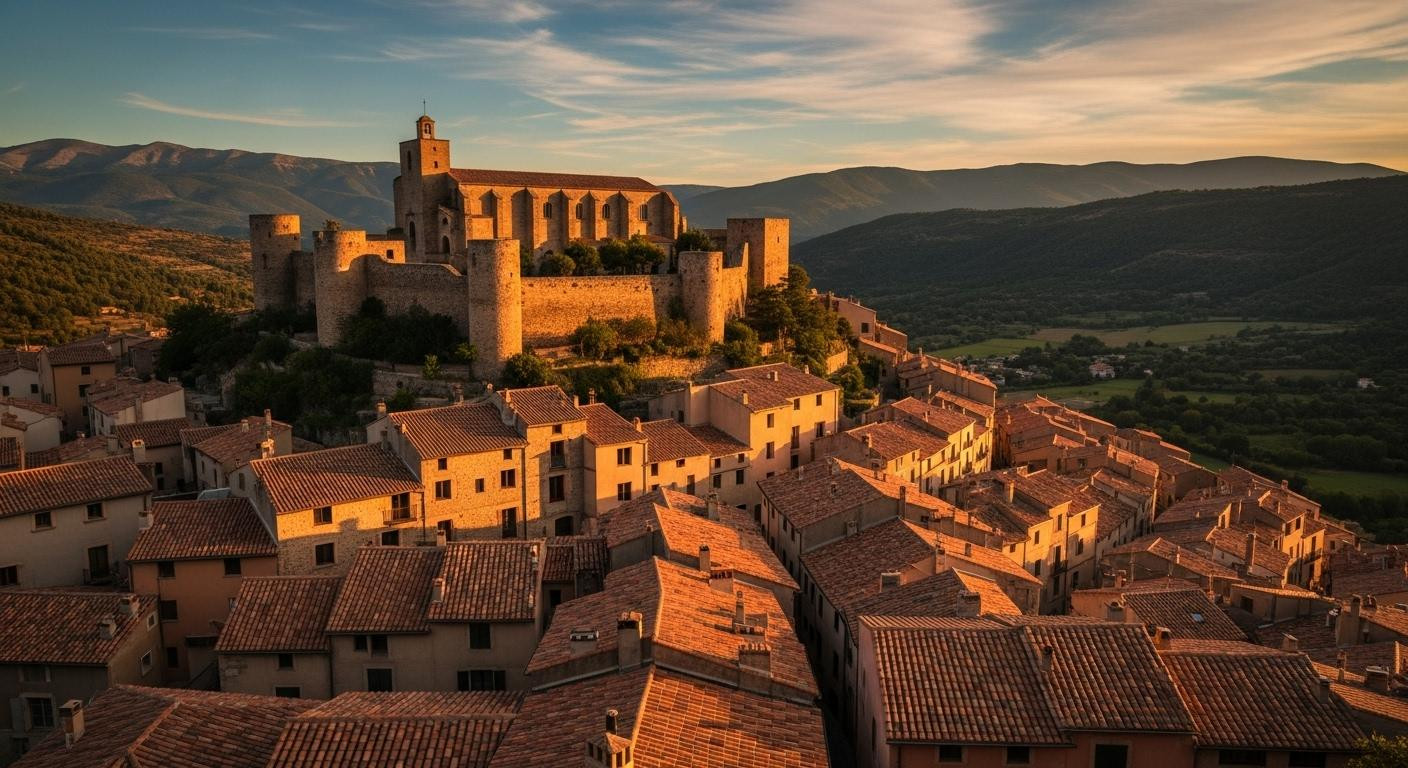Dawn breaks at 6:47 AM in Castelnou, where terracotta rooftops catch first light like embers against grey stone walls. Steam rises from the village bakery while the 10th-century Château de Castelnou stands silent above. This isn’t Provence’s commercialized hilltowns drawing millions. This is Catalan France, where 200 permanent residents welcome 491,000 annual visitors to one of France’s “Most Beautiful Villages” without losing their medieval soul.
Where medieval Catalan France glows at 1,312 feet
Castelnou perches at 1,312 feet elevation in the Pyrénées-Orientales, 28 miles from Perpignan, 93 miles from the Spanish border. The village occupies 12 square miles of the Aspres region, with Mont Canigou (9,137 feet) dominating the western horizon. Those terracotta roofs aren’t decorative. They’re traditional Catalan clay tiles that glow amber when low-angle sunlight activates their iron oxide composition between 5:30-6:15 PM from April through September.
The Château de Castelnou, built 988-990 AD, rises above as France’s oldest surviving viscounty fortress. Stone walls erected in the 13th century still encircle the village core. Access requires a 28-mile drive from Perpignan-Rivesaltes Airport. No train service preserves the quiet. Average $77/night accommodation versus Provence’s $165+.
What 200 residents guard in 13th-century streets
The terracotta architecture that captures light
Traditional Catalan clay tiles cover every roof. No modern materials permitted under heritage protection. These tiles contain iron oxide that oxidizes amber when sunlight hits at 15-degree angles during spring and summer evenings. Golden stone walls amplify the effect. Narrow cobblestone streets (5-7 feet wide) concentrate the glow for 45 minutes as sun descends behind Canigou.
The artisan workshops in medieval buildings
Pottery studios occupy former guard towers. Jewelry ateliers fill 14th-century merchant houses. Textile workshops operate in converted stables. These aren’t tourist shops but working artisans selling directly, demonstrating centuries-old Catalan techniques. No chain stores permitted. Similar amber-glowing villages exist across southern France, but none preserve this level of artisan authenticity.
Living medieval France at $22 per experience
What locals do before tourists arrive
Morning markets (8:00 AM, Saturdays) sell Canigou honey, local cheeses, Collioure anchovies with no tourist markups. Bakeries open 6:30 AM with authentic Catalan pastries ($2-$4). The village trail to Château de Castelnou costs $7-$9, includes rampart walks with panoramic Pyrenees views. Guided village tours ($11-$17) reveal hidden courtyards tourists miss.
The Catalan cuisine that stays authentic
Restaurants serve traditional Catalan tapas ($17-$28/person), paella, mountain cheeses instead of French bistro adaptations. Local wines from Côtes du Roussillon vineyards ($13-$20/bottle). The Fête de la Saint-Jean (midsummer) features traditional Catalan bonfires and sardana dancing as community event, not tourist spectacle. Villages maintaining authentic traditions are increasingly rare in France’s tourism landscape.
Why Provence’s crowds miss this
Gordes (35 miles northwest) draws millions with similar hilltop medieval architecture and golden stone but charges $165+ nightly, battles tour bus traffic, restricts village center to residents. Castelnou offers identical preservation at $77/night, zero tour buses (road width prohibits), open village exploration. The difference: Gordes markets itself; Castelnou relies on word-of-mouth. Less crowded destinations often provide more authentic experiences than their famous counterparts.
Your questions about this tiny village of Castelnou answered
When does the terracotta glow actually happen?
April-September evenings (5:30-6:15 PM) offer peak glow as sun descends behind Canigou at 15-degree angles. Autumn mornings (7:00-7:45 AM) provide secondary effect with eastern light. Overcast days eliminate the phenomenon since iron oxide requires direct sunlight. Spring (March-May) and autumn (September-November) balance optimal light with 60% fewer visitors than summer.
How do 200 residents handle 491,000 visitors?
No hotels within village walls. Accommodation spreads across surrounding Aspres region, preventing overnight crowding. Day visitors peak 10 AM-4 PM while locals guard dawn and dusk quiet. Narrow medieval streets naturally limit crowd density. No parking in village center; lots 1,300 feet downhill filter gradual arrival. Small communities preserving authenticity share similar visitor management strategies.
What makes this different from Provence’s hilltowns?
Catalan culture versus Provençal means different language roots, architectural traditions, culinary influences. Closer to Spain (93 miles) than Paris (497 miles). Pyrenees backdrop versus Luberon valleys. Lower tourism pressure maintains working village versus museum-town feeling. $77 versus $165+ accommodation reflects authentic local economy, not inflated tourist pricing.
At 6:15 PM, the last amber light fades from terracotta rooftops while the Château silhouette darkens against Canigou’s peak. A potter locks her medieval workshop. The scent of Catalan bread drifts through cobblestone silence. Tomorrow, 200 residents will wake before the glow returns, before visitors discover what locals have guarded 1,037 years.
